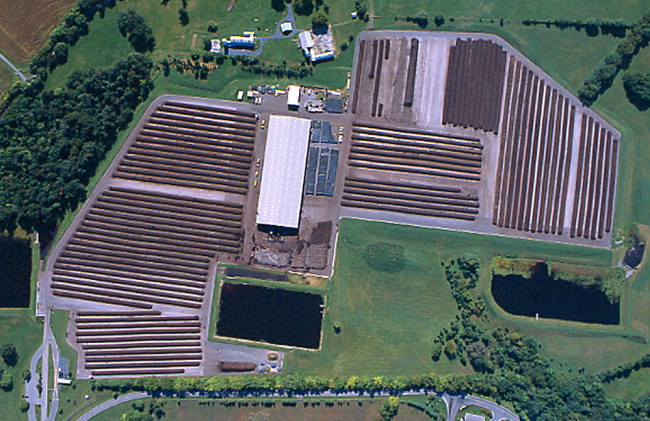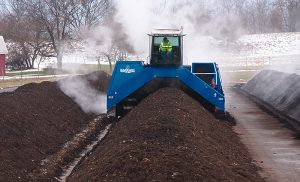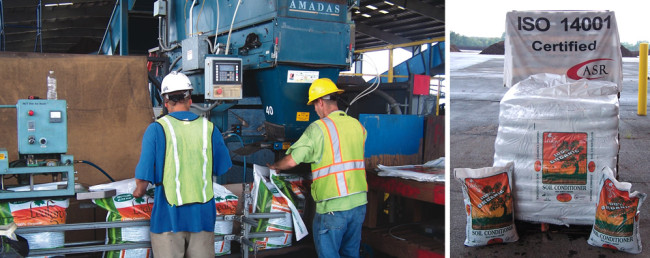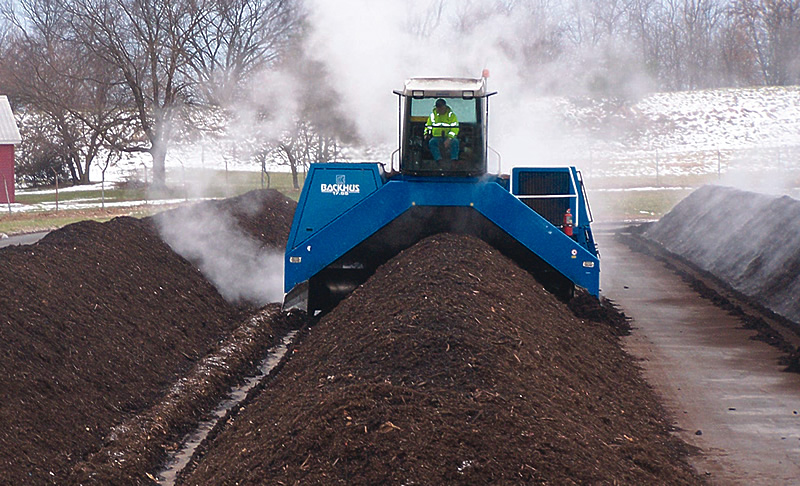The steps to implementing an Environmental Management System at the Dickerson Composting Facility in Maryland, and the benefits to both the community and the operation, are described.
Marilu Enciso
BioCycle January 2014

The Montgomery County yard trimmings composting facility sits on a 48-acre asphalt pad. After curing, compost is moved under an 80,000 square foot pavilion (center), where it is allowed to fully mature.
Initially, only leaves collected by the County’s curbside leaf vacuuming collection program, serving about one-third of the county, were composted. In 1989, the program was expanded to include both leaves and grass collected at all single-family homes in the county. Today, materials are received from the entire county, representing a population of about one million (including all single-family homes, multifamily dwellings and business establishments).
The MCYTCF is limited to receiving no more than 77,000 tons/year of leaves and grass per an agreement with the host community in Dickerson. In some prior years, the total tonnages of leaves and grass received by the county have exceeded this limit, requiring the county to use back-up
contracted composting facilities. However, over the last seven years, successful promotion of grasscycling (e.g. use of mulching mowers) and backyard composting has reduced incoming leaves and grass to an average of only 70,395 tons/year. Possibly the most important component of the Leafgro formula is Montgomery County citizens, who not only have reduced the amount of yard trimmings placed at the curb for collection, but have complied with the County’s ban on use of film plastic bags to set out yard trimmings.
A second important factor is removal of brush (woody materials) not suited to rapid composting. All types of yard trimmings — leaves, grass and brush — are accepted at Montgomery County’s centrally-located Transfer Station in Derwood, Maryland. At the Transfer Station, brush is visually separated out of incoming loads, then ground and separately marketed, directly from that site, for mulch. In the absence of big storms, that amount averages around 50,000 tons/year. This process involves three grinders, a grapple, and four loaders operating in a separate 2.5-acre space. It assures, to the greatest extent practicable, that only leaves and grass are transported 20 miles west to Dickerson, where they are composted. In addition, all leaves and grass received at the Transfer Station are run through grinders there to improve transportation efficiency and aid in subsequent composting. MES also operates all yard trimmings operations at the Transfer Station.
The Composting Process
In the fall, leaves are deposited into long windrows, approximately 8-feet high and 10-feet wide using front-end loaders. In the spring, grass is added to the existing rows of material; the ratio of grass to leaves can vary from 1-to-1 to 1-to-2. The windrows are periodically turned to accelerate the composting process. The temperature of each row is monitored at least once per week by MES staff. Monitoring is supplemented at night and on weekends by security guards. Temperature is maintained between 140°F and 160°F; piles exceeding 170°F receive additional turning and/or watering and are remonitored. Moisture is monitored weekly using a simple squeeze test (target is 40% moisture). If free liquid is released, then the compost is too moist; if it clumps and crumbles then it is too dry. To reduce moisture the compost is sun-dried by spreading it out on the asphalt pad on sunny days. When it is too dry, the windrows are sprayed with pond water. The windrows are turned using Backhus and Scarab turners.

Fall leaves are deposited in long windrows, approximately 8-feet high and 10-feet wide. In the spring, grass is added to the existing rows and the windrows are turned periodically.
By late summer, the material is ready to be screened for sale. The MCYTCF uses two drum-style screeners equipped with three-eighth-inch screens to improve the quality of the finished compost. Screening to this size removes twigs and larger pieces that have not yet broken down, as well as impurities such as film plastic, tennis balls, pet toys, metal and other items that would be regarded by the Leafgro® market as contaminants. On a volume basis, about 10 percent of the screener throughput is comprised of such oversized materials. However, these “overs” are further processed using a vacuum device and drum magnet, both strategically positioned on the overs exit ramp from the screener. Cleaning the overs yields approximately 10 tons/year of scrap metal (which is recycled) as well as about 135 tons of vacuumed off dirty film plastic and tennis balls that become a minor waste stream. The cleaned overs are sold directly into the ground cover market.
Even though residents are required to use paper bags or reusable containers in the curbside collection program, plastic bags continue to slip into the collected material. As the tub grinders and the turners break the yard trimmings into smaller pieces, one plastic bag easily becomes hundreds of tiny shreds. These pieces litter the facility when blown out of the windrow by the wind. Last year, 858 pounds of film plastic litter were collected from the fence line (in addition to the 135 tons of plastic and other lightweight contaminants vacuumed from the end product).
Of outgoing products, approximately 90 percent by volume is Leafgro® (38% bagged and 52% bulk); about 10 percent is screened overs. Bagging is accomplished on-site using two Amadas electric bagging lines complete with palletizers. These lines are classified as manual, requiring six laborers, including a palletizer and forklift operator. Each bag produced is 1.5 cubic feet volume using a standard volume for calibration, and each pallet contains 50 bags. An experiment with 1.0 cubic foot bags demonstrated a market preference for the 1.5 cubic foot bag. The site produces 500,000 bags of Leafgro per year.
MES is also responsible for product marketing. All distribution is limited to wholesale buyers. This is achieved by setting lower limits on the size of outgoing loads, and is done to minimize traffic impact on the host community. (With respect to the Environmental Management System discussed in the next section, this also helps reduce greenhouse gas emissions associated with product distribution.) Products are marketed to distributors, garden centers, and to other wholesale purchasers throughout the Mid-Atlantic region. Big box stores and garden centers cater to regional homeowner and landscaper demand by carrying bagged Leafgro. Most garden centers carry both the bulk and bagged product. In recognition of outstanding marketing results, MES and Montgomery County were awarded the SWANA Gold Marketing Excellence Award for 2012 — the top marketing award available. Leafgro has been used to enhance notable Washington-Baltimore area places, such as: FedEx Field, Raven’s Stadium, Oriole Park, and the Vice President’s Residence.
The county’s annual cost of composting operations, including preprocessing (grinding) at the Transfer Station, net of product sales, inclusive of capital replacement costs but exclusive of transportation, averaged $2.5 million/year for the five year FY09-FY13 period.
Environmental Management System
In 1998, the County established a host community group, the Dickerson Area Facilities Implementation Group (DAFIG), for the purpose of advising the county on management of its solid waste facilities located in the Dickerson area. Members of DAFIG are nominated by the County Executive and appointed by the County Council. (A waste-to-energy facility and a potential future landfill were also sited in the area.) An early request of the DAFIG was that the county should look into developing a formal Environmental Management System to manage the environmental aspects of its composting facility.
An Environmental Management System (EMS) follows a “Plan-Do-Check-Act” cycle that involves four steps: 1) Developing an environmental policy; 2) Planning; 3) Implementation; and 4) Checking and acting to assure continual improvement. There are a variety of EMS approaches. The DAFIG had indicated specific interest in the ISO 14001 Environmental Management System. (ISO stands for the Greek word “isos” for equal.) The ISO 14001:2004 standard is the result of a collaborative international effort to address environmental challenges. The primary objective is to provide a process-oriented approach to environmental management that allows all types and sizes of organizations, regardless of their particular business, to systematically do the following:
• Develop environmental programs which take into account legal requirements and information about significant environmental aspects of their operations
• Prevent pollution
• Improve their environmental performance, going beyond regulatory compliance
• Enhance the corporate image among regulators, customers and the public
• Continuously improve environmental performance
In 2011, after conducting a gap analysis — comparing what programs it already had in place with the ISO standard — Montgomery County management decided to pursue the rigorous ISO approach and develop a formal EMS that could be externally certifiable under the ISO 14001-2004 standard. Its Fiscal Year (FY) 2012 would be dedicated to developing the program, and the County would seek external certification the following fiscal year. MES and the DAFIG embraced the program. MES headquarters and field staff were engaged to learn the standard and develop the procedures and programs needed under the standard, and DAFIG formed an EMS subcommittee to work with the county. An EMS Team of county and MES staff was established to develop the program. The scope of the EMS was to cover all operations occurring on the composting facility site, but also important to the DAFIG was to include inbound and outbound transportation to the extent controllable by the county.

Bagging is done on-site using two Amadas electric bagging lines complete with palletizers (left). Leafgro® is sold in 1.5 cubic foot bags (right), as well as in bulk.
Steps To EMS Implementation
Define the Organization’s Environmental Policy
The first step in developing the EMS was for top management to establish the Environmental Policy that would govern development of the EMS. On June 20, 2011, a statement of the Environmental Policy for the MCYTCF was signed by Bob Hoyt, Director of the County’s Department of Environmental Protection. The Policy Statement was communicated to all stakeholders including the community, suppliers and product buyers.
Identify Significant Environmental Aspects and Impacts
Another important step in the ISO process is to identify the facility or organization’s “Significant Environmental Impacts” (SEI). For the composting facility, this meant identification of the SEIs of the composting process and all the ancillary operations within the scope of the EMS. In ISO parlance, an environmental “aspect” is “an element of an organization’s activities, products or services that can interact with the environment,” and an “impact” is “any change in the environment, whether adverse or beneficial, wholly or partially resulting from an aspect.”
To develop its list of SEIs, the EMS team took a process-oriented approach to inventorying all environmental aspects and impacts within the scope of the EMS. All physical processes within the scope of the EMS were identified (e.g. inbound transportation, receiving, windrow creation and management, curing, screening, bagging, storm water control ponds, equipment maintenance, fuel storage, administration, etc.) and broken down in to subprocesses, and then potential environmental impacts described for each. This was essentially a brainstorming exercise, and forced out-of-the box, global thinking about the potential environmental consequences of all site activities. A list of 182 aspects and impacts was generated. With input from the DAFIG, the detailed list was then rank-ordered and common impacts consolidated and combined, yielding a short list of SEIs. The current summary list of SEIs is as follows:
• Potential for fire hazard
• Nuisance odors as a form of air pollution
• Air pollution, direct emissions, from transportation and site operations
• Air pollution, indirect greenhouse gas effects of fossil fuel usage
• Surface water quality degradation
• Dust as air quality degradation
• Ground water contamination
• Litter pollution as impairs aesthetics, visual contamination
• Use of natural resources
Develop Environmental Management Programs to Address SEIs.
Programs must have stated objectives to address aspects generating an SEI, measurable targets to reduce an SEI, designated responsible parties and timelines. Currently, the facility staff is working on Programs focused on the following Aspects (and associate SEI):
• Decomposition of yard trimmings in windrows (potential for fire hazard and odors)
• Trucking transportation from the transfer station to the facility (traffic and air pollution)
• Machinery operation (air pollution)
Pond discharges (water quality degradation)
• Dust generation (dust as air quality degradation)
• Oil spill management (surface and/or groundwater contamination)
• Impurities coming out of the windrows as a form of litter (visual contamination)
• Use of electricity across the facility (air pollution)
• Green purchasing (use of natural resources)
• Lighting Efficiency Retrofit (air pollution, indirect greenhouse gasses)
Continuous Environmental Improvement
Already achieved environmental improvements have been seen throughout the implementation of programs such as the following:
Eliminating a Fire Hazard: To improve sale of the screened overs discussed earlier, roughly 8,000 tons/year of the material were being further processed by tub grinder and then rescreened. The resulting material had proven acceptable to nurseries (though at about half the selling price of bulk Leafgro). This extra processing was relatively expensive, and also had environmental drawbacks that were brought under scrutiny by the EMS. Not only was the grinder a relative fuel guzzler, but with two engines and the tendency of fine particles to accumulate on hot metal machine surfaces, grinding represented a real potential source of fire at the composting facility. Addressing both the fire hazard and fossil fuel consumption, an EMS Program was created with the objective of marketing overs without grinding. The challenge was to increase the plastics and metals removal from about 65 percent efficiency to over 90 percent without purchasing added equipment. With tinkering and adjustments to the existing overhead belt magnet and vacuum devices attached to the outfeed conveyor of the Leafgro screener, MES mechanics were able to achieve sufficient purity. A new “clean, unground overs” product is now generated during routine compost final screening. As a side benefit, about $2,000/year of ferrous are recycled.
Fossil Fuel Consumption by Inbound and Outbound Transportation: Although transportation contractors’ fuel savings may not necessarily accrue to the county, it was recognized there could be environmental benefits from more fuel-efficient transportation. The following steps have been taken:
• Establishing a Standard Operating Procedure (SOP) that assures maximum use of rail haul in lieu of trucking for inbound materials from the Transfer Station. During FY2013 almost 60 percent (by weight) of yard trimmings was transported by rail.
• Similarly, the efficiency of outbound transportation (of product) was improved by 5.7 percent measured as tons out per truck trip. (All product is distributed by truck; no rail.) This was achieved by strict adherence to minimum truckload sizes.
• Targeted stakeholder outreach communication to the inbound trucking contractor, Team Transport, Inc., regarding the EMS and its objectives, has reportedly resulted in accelerated fleet replacement of six (rather than four) tractors plus voluntary purchase of “inside-outside doors” for all walking floor trailers which can reduce drag fuel usage significantly.
Fossil Fuel Consumption by On-Site Equipment: One loader replacement by the County has already reduced loader fuel usage by about 2.06 gallons/operating hour (a reduction 2,400 of gallon/year). In addition, site mowing was outsourced to a local farmer (see box).
Dust Generation by Windrow Turners: Dust generation by machinery, and the potential resulting degradation of local air quality, was judged a Significant Environmental Aspect and Impact. As a responsive Environmental Management Program, two talented mechanics used their ingenuity and in-house materials to build in a canopy for a Backhus windrow turner, reducing dust and saving the county a significant expense.
Site Litter and Odor: As noted above, other Significant Environmental Impacts included site litter and odors. After 18 months of implementing two new SOPs to address litter and odor, and increasing regular litter patrolling of the fence line, it was decided to measure the perception of both site cleanliness and odors by tour visitors as well as regular visiting truck drivers by polling them during the spring months of 2013. The results:
• Ninety-one percent of the visitors did not perceive litter at the facility. When asked to quantify how cleanliness, 65 percent said it was “clean” and 28 percent “spotless.” Sixty-seven percent did not perceive any kind of odor at all.
• Ninety percent of the truck drivers did not perceive any litter on the fence or any odors. When asked about the cleanliness, 100 percent considered the site either “spotless” (10%) or “clean” (90%).
There has not been an odor complaint regarding the composting facility since well before the EMS’s odor SOP was instituted. Under the SOP:
• Incoming grass must be mixed with leaves the same day, and windrows when first created must be capped with a mixture that contains no less than two parts leaves to one part grass;
• Whenever wind is blowing in the direction of nearby residences, no incoming grass with odor can be added to windrows in “Area A” (an approximately 20-acre area of asphalt composting pad located nearest to residences), and any turning of the windrows is delayed unless pile temperatures exceed 170°F.
• Turn windrows on at least a weekly basis in order to add oxygen and keep the process aerobic;
• If odor is ever clearly perceived, a layer of 3 to 6 inches of finished product should be placed on the offending row. (This last provision has not yet been needed.)
Results and Lessons Learn
Once a company or organization has implemented an EMS under ISO 14001:2004, it may opt to prove that it has achieved full alignment or conformity with the international standard. Options to prove the standards have been met include making a self-determination and self-declaration, seeking confirmation of conformance by external parties or having an accredited third party certifier. In anticipation of using a third party certifier, the County contracted an external auditor for two days in July 2012 to informally evaluate the EMS and its readiness to a full external certification process. This provided “a fresh pair of eyes” to fine-tune the program.
In June 2013, the accreditation company, American System Registrar (ASR), was retained to conduct the external certification audit. ASR’s detailed audit showed that the MCYTCF had demonstrated continuous improvement in the areas of environmental performance, regulatory compliance and pollution prevention, and as of July 27, 2013, the EMS of the facility was registered as certified in full conformance with ISO14001: 2004. The certification is valid for three years, but is subject to annual external surveillance audits. With its certification, Montgomery County’s Dickerson Yard Trimmings Composting Facility becomes the second yard trimmings composting facility in the U.S. with an EMS that is ISO 14001 certified. The first is Cedar Grove Composting in Seattle, Washington. (The National Biosolids Partnership has developed an EMS program for biosolids facilities, including composting, which is different than the ISO14001:2004 utilized for the County’s certification.)
Not all improvement appears overnight, but even in a short time since the inception of the EMS, there have been administrative, operational and environmental improvements. Initially there was some inertia in motivating field staff, but as a better understanding of the program developed, important teamwork advanced and enthusiasm grew naturally. Administratively, the MCYTCF now has written operational controls, which means personnel are being trained on critical aspects of the operation and the environmental consequences of not following the written procedures. The level of environmental awareness has increased in field personnel.
The challenges have included: Time for implementation of the standard initially seemed an overwhelming new obligation competing with normal operations; additional paperwork for maintaining records; additional time needed to complete corrective actions; and time to maintain EMS documentation.
The benefits have included: Positive community recognition; competitive edge; better understanding of compliance requirements; reduction of discovered excessive inspections and unnecessary record keeping; increase of environmental awareness by contractors, suppliers and buyers; improved environmental performance; improved environmental training; environmental awareness of staff; and continuous environmental improvement.
A significant challenge is finding time to create and complete corrective actions to fix deviations from the EMS discovered during internal audits. While the EMS is new, there can seem to be conflicting work priorities. The key is to embrace EMS procedures and documentation simply as elements of good management rather than new burdens conflicting with old habits of daily operations. Overall, the main expense for the critical first year of intensive program development and implementation was staff time.
At a celebration luncheon in October 2013, community stakeholders and county officials commended the staff on their accomplishments. A county manager noted his pleasure and surprise that the independent auditor had reported that not only had each and every operator understood the official Environmental Policy, but that each had demonstrated a grasp of how his or her own operating behavior could impact the environment and what could be done to avoid or reduce the environmental impact. The Operator, Danny Baugher responded, “That’s not just some side benefit; it’s a basic reason for having an EMS.”
Marilu Enciso is a Senior Planning Specialist with the Montgomery County (Maryland) Division of Solid Waste Services. She served as a facilitator of the EMS creation and implementation due to her personal experience in ISO 14001 as well as her qualifications as Lead Auditor.










